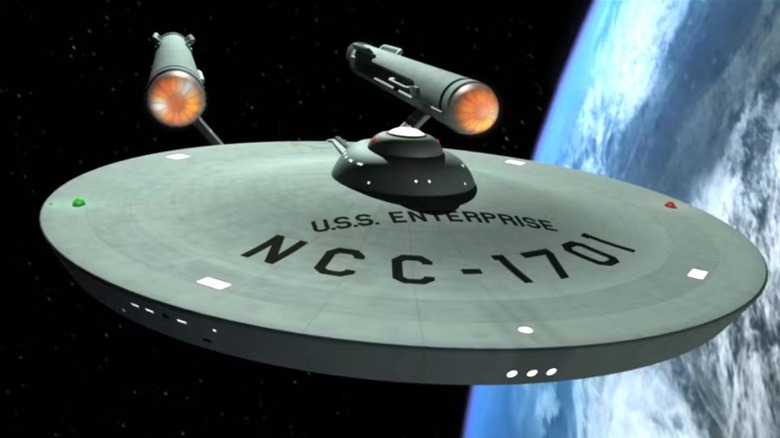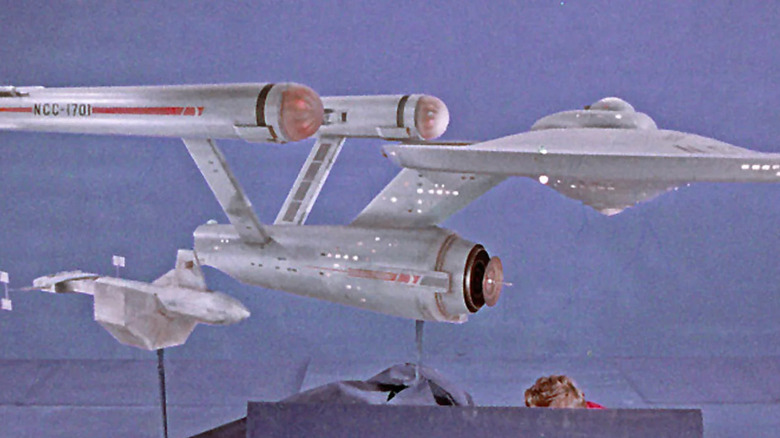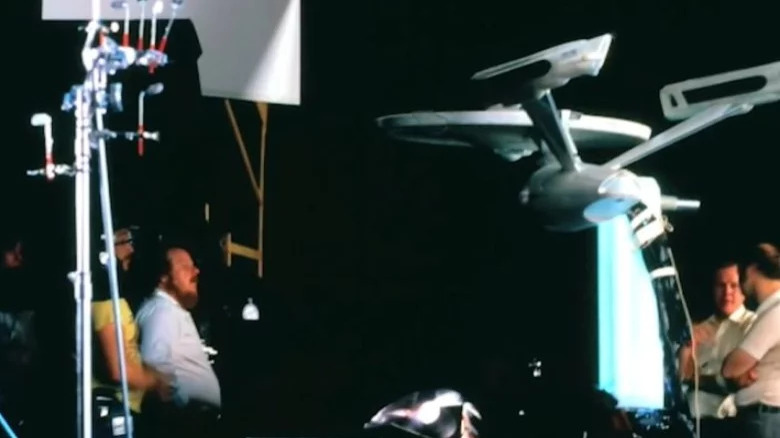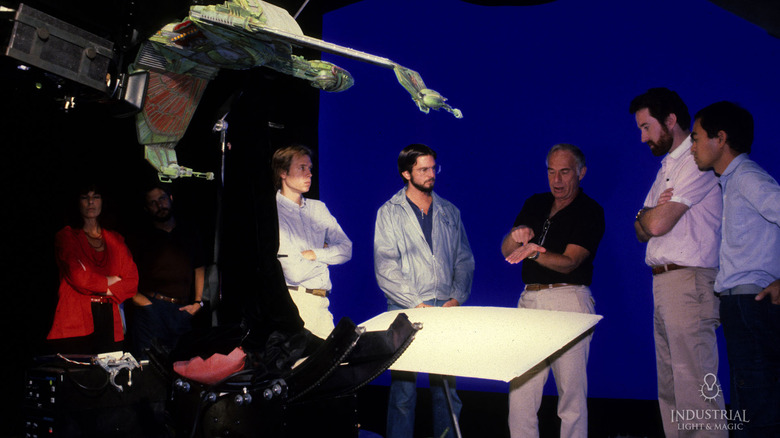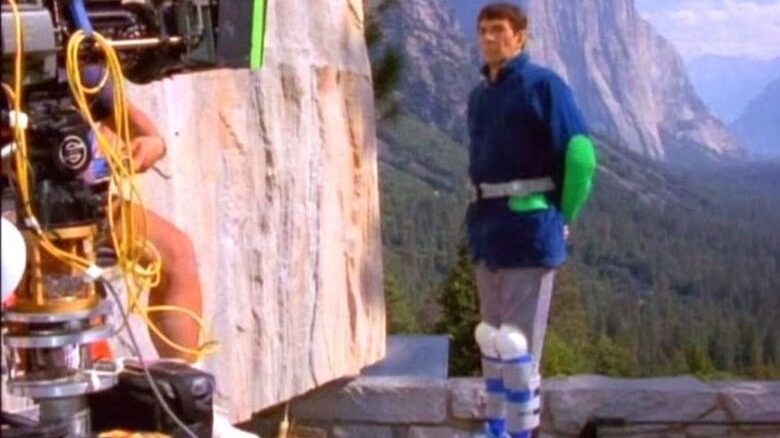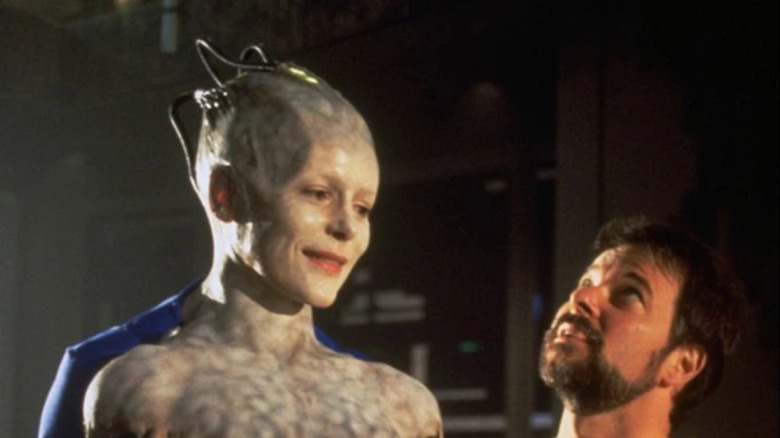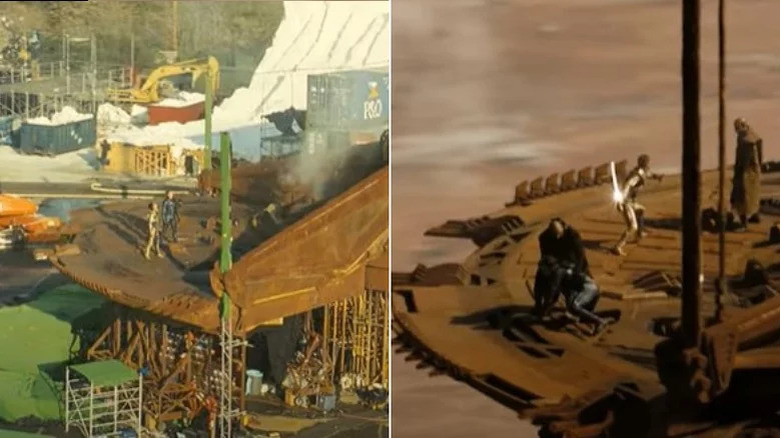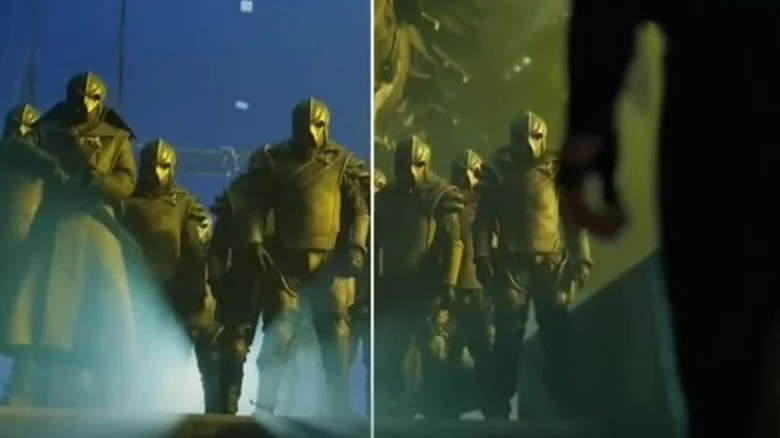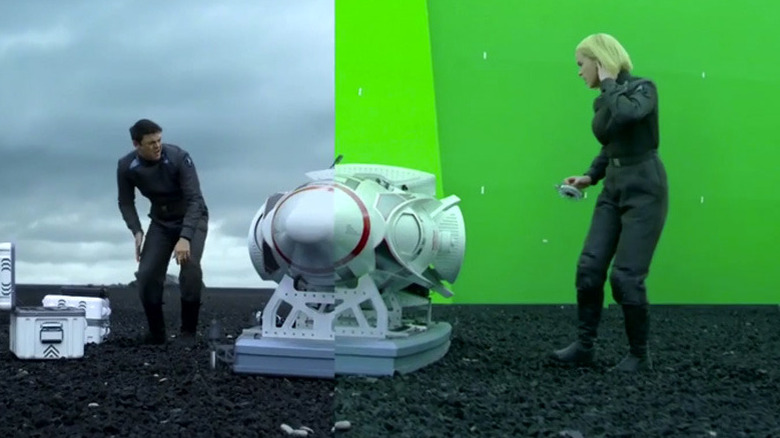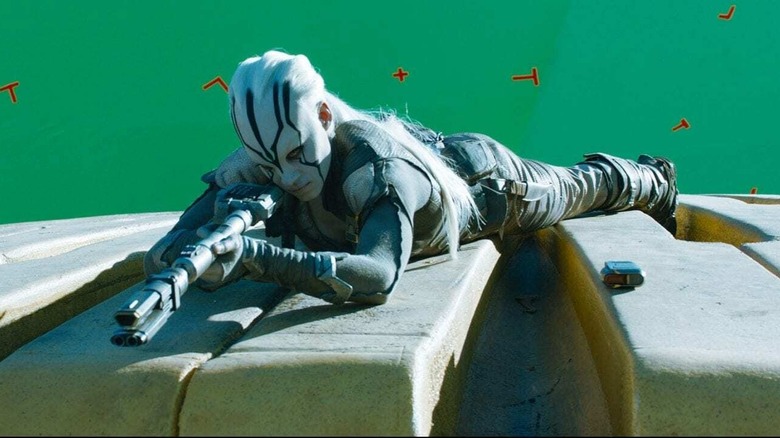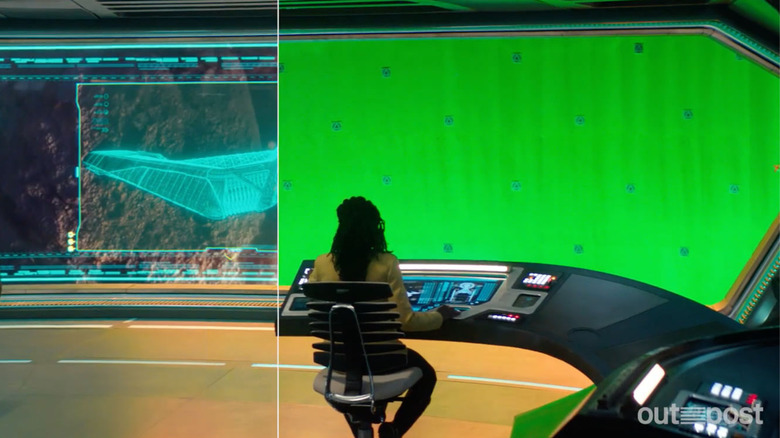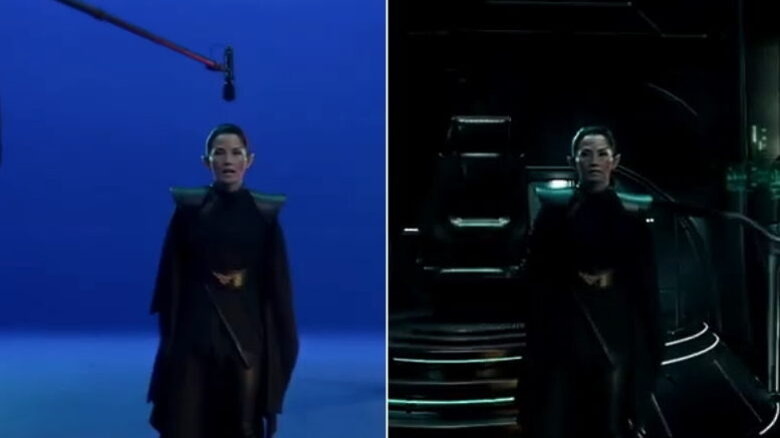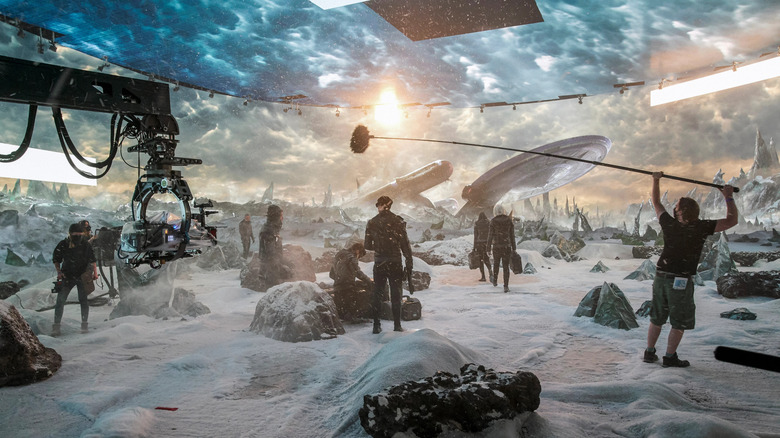What Star Trek Looks Like Before Special Effects
"Star Trek" is one of the most iconic and enduring science fiction franchises of all time, following the adventures of Starfleet in the far-future as they explore space, the final frontier. To bring strange new worlds and civilizations to life, "Star Trek" leans heavily into visual effects, many of them cutting edge for technology available at the time. These special effects did everything from showcasing the starship Enterprise to making the ship's memorable transporter look seamlessly functional. Simply put, "Star Trek" wouldn't be what it is without its meticulously realized visual effects.
It takes a whole team and a whole process to bring these futuristic sights to the screen and these behind-the-scenes photographs offer a look at how it was all made. From extensive use of models and bluescreen to modern digital projection, "Star Trek" uses every visual effect trick in the book to thrill audiences. Here is what "Star Trek" looks like before all the special effects magic.
Khan gets his own space ride
One of the most notable episodes from "Star Trek: The Original Series" is "Space Seed" from the first season. The episode introduces genetic superhuman Khan Noonien Singh (Ricardo Montalban), who went on to become the primary antagonist in "Star Trek II: The Wrath of Khan" in 1982. Khan and his fellow superhumans are exiled from Earth on an automated freighter, the Botany Bay, encountered centuries later by the Enterprise. After finding the ship in deep space, the Enterprise docks alongside it to investigate the wayward starship for themselves.
American Cinematographer recalled the lengths the production went to capture the deep space adventures of the Enterprise, using a number of different effects. Like the Enterprise, the Botany Bay had its own scale model constructed, a technique used since the series' second episode "Charlie X." Both ships were filmed together against a blue screen, with the starry background added to the shot in post-production. This method demonstrates the scale of the Enterprise, compared to the much smaller freighter.
The Enterprise takes flight again
A full decade after the cancellation of "The Original Series," fans were treated to the return of the Enterprise and its crew with 1979's "Star Trek: The Motion Picture." A special reverence was taken in bringing the Enterprise to the big screen, including a sequence of Kirk and Scotty touring the outside of the hull in a shuttlecraft. After reuniting on board, the Enterprise sets out to confront V'Ger, a cloud-like entity headed towards Earth destroying all in its path. Like many visual effects of the era, the Enterprise's recommissioned voyage is a mix of practical and digital effects.
The behind-the-scenes documentary "Sense of Scale" depicts the painstaking attention to detail and work that went into creating the Enterprise model for "The Motion Picture." A photo from the documentary by Piercefilm Productions reveals the sheer size of the Enterprise model during production on the 1979 movie. Crew members around the model assemble plates, which will be used to impose the Enterprise in space in post-production. Back and literally bigger than ever, the Enterprise's cinematic debut used the best in contemporary special effects technology to impress audiences.
The Klingons strike in Star Trek III
Leonard Nimoy took the helm of 1984's "Star Trek III: The Search for Spock," pitting the Enterprise against the Klingons. The longtime "Star Trek" enemies make their grand entrance in the film as their Bird of Prey decloaks while searching for information on the Genesis Project. The sight is one of the more impressive moments in the film, firmly reestablishing the Klingons as a genuine threat. For help developing the visual effects for "The Search for Spock," Nimoy turned to "Star Wars" effects company Industrial Light & Magic.
Nimoy approached ILM early during production on "Star Trek III," creating scale models for the Bird of Prey and Starfleet's orbital space station, Spacedock. A behind-the-scenes photo from the production shows VFX supervisor Ken Ralston working with ILM for shots involving the Bird of Prey. Impressed by their work on "Star Trek III," Nimoy collaborated with ILM when he resumed his directorial duties for "Star Trek IV: The Voyage Home."
Spock joins Kirk at Yellowstone
The first time Captain Kirk and his friends are seen in 1989's "Star Trek V: The Final Frontier," they aren't on an interplanetary mission, but enjoying a much-needed vacation. Kirk, Spock, and McCoy decide to go on a camping trip at Yellowstone, with Kirk going on a free solo climb of El Capitan. Spock interrupts his climb, rapidly catching up with the aid of hover boots, to question why his friend would indulge in such a dangerous activity. While long shots were filmed on location at El Capitan, the close-up shots involving actors William Shatner and Leonard Nimoy were not.
This behind-the-scenes picture from the special edition DVD release of the movie shows Nimoy standing comfortably on a platform, with a fiberglass composite of El Capitan's face positioned next to him and Shatner. Yosemite and its sweeping vista is seen in the background, with the production taking advantage of the on-location filming. Having the actual landscape in frame helps lend the illusion that Kirk and Spock are actually by Yosemite as Kirk makes his daring climb.
The Borg Queen makes her entrance
One of the most sinister antagonists in all of "Star Trek" is the Borg Queen, introduced in 1996's "Star Trek: First Contact." After the Borg Collective infiltrates the Enterprise, turning its engineering bay into a makeshift headquarters, the Queen reveals herself to Data. As the Queen delivers her opening monologue, the upper half of her torso is lowered onto a waiting body. Seamlessly executed, the Queen attaches to her lower half and walks to Data in a single take, without missing a beat.
A behind-the-scenes photo from Paramount Pictures shows "First Contact" director Jonathan Frakes on set with actor Alice Krige in her Borg make-up. The robotic torso is fixed to the floor while Krige's lower half is covered by bluescreen material to facilitate the illusion of it initially being missing. Though Krige moves normally during filming, post-production creates the effect of her affixing to her body and walking. The resulting scene is one of the most visually impressive moments in "Star Trek" history, with a variety of tricks used to bring it all together.
The Star Trek reboot's innovative outdoor shoot
When filmmaker J.J. Abrams resurrected "Star Trek," starting with an eponymous reboot film in 2009, this new take on the franchise had a decidedly more action-oriented approach. One of the biggest set pieces in the 2009 movie has Kirk and Sulu skydiving from a shuttlecraft above Vulcan onto a Romulan mining platform blasting into the planet. While the precariously hanging platform, Kirk and Sulu fight the Romulans operating it before destroying it in a desperate bid to save Vulcan. Rather than being filmed inside of a studio, the sequence was filmed outside, albeit far from being shot on-location.
Footage from an Industrial Light & Magic "Star Trek" featurette shows production of the mining platform scene, which reveals that it was shot in a parking lot. This exterior approach gave the scene the natural feeling that the actors were outside while still in a tightly controlled environment. The skies above Vulcan and, of course, the massive mining laser, were added digitally in post-production, with greenscreen on the ground to facilitate this. This approach paid off, with "Star Trek" earning an Academy Award nomination for Best Visual Effects for its hard work.
The Klingon home world is a digital construction
One of the biggest action set pieces in "Star Trek Into Darkness" involves a covert mission to recover the villainous Khan (now played by Benedict Cumberbatch) on the Klingon home world of Kronos. The Klingons themselves are heavily redesigned from past "Star Trek" appearances, introduced moments before Khan massacres them in a prolonged gunfight. The battle is set in a rocky region of Kronos, with ash atmospherically falling around the combatants before Khan surrenders himself to Kirk and his landing party. Of course, none of the background on Kronos is actually real.
While the costumed actors are on set for the Kronos sequence, the landscape around them was created and superimposed around them via blue screen, as revealed in a VFX reel from Pixomondo. Lights around the set help make the Klingons appear more intimidating, lending a subtle shadow effect. With so much of "Star Trek Into Darkness" set in Starfleet locations, Kronos is among the most visually striking places in the movie. And though the entire sequence feels like it's shot on a soundstage, how much of it never physically existed is a bit surprising.
Star Trek Into Darkness digitally creates another planet
To take down Khan in "Star Trek Into Darkness," Starfleet Admiral Alexander Marcus (Peter Weller) has the Enterprise loaded with specially designed torpedoes. Suspicious about this secret weapon, Hank McCoy (Karl Urban) and Doctor Carol Marcus (Alice Eve) defuse and disassemble one of the torpedoes on a remote planet. A brief but tense scene in the movie, things nearly turn explosive when the torpedo's failsafe program is accidentally triggered until it is successfully disarmed. Though the landscape resembles any number of Hollywood productions filmed in expansive exteriors like Iceland, it was digitally constructed.
Like Kronos, the planet where McCoy and Marcus carry out their dangerous investigation was largely created in post-production. Actors Karl Urban and Alice Eve stand on set in costume, with the ground and torpedo prop also physically on set. However, as revealed in a behind-the-scenes photo from Atomic Fiction, the background was created through green screen behind the actors. In comparison to its predecessor, so much of "Star Trek Into Darkness" takes place outdoors, with the production digitally creating distinct environments for the story to unfold in.
Star Trek Beyond puts Jaylah into focus
Whereas much of the action in "Star Trek Into Darkness" takes place on the Enterprise, its sequel "Star Trek Beyond" takes place on solid, if unfamiliar, ground. The 2016 movie opens with the Enterprise lured into a trap on the faraway planet Altamid where it crashes on the surface. As the crew faces the villainous Krall, they are joined by the formidable scavenger Jaylah, who has her own violent history with Krall. Taking refuge in the wreckage of the lost Starfleet vessel the USS Franklin, Jaylah is prepared to deal with any enemies with extreme prejudice.
Like many of the planetary environments in "Star Trek Into Darkness," Altamid is similarly largely created from special effects magic. A behind-the-scenes photo from Rodeo FX depicts actor Sofia Boutella in full costume and makeup as Jaylah taking aim with a sniper rifle. Though the wreckage of the Franklin is a physical presence on set, the mountainous background was created through a green screen behind the actor. Like 2009's "Star Trek," the Altamid exteriors were filmed outdoors, to give the movie a natural lighting to help accentuate the illusion.
The USS Discovery's window to the galaxy
The start of this new wave of "Star Trek" programming on Paramount+ began with the prequel series "Star Trek: Discovery" in 2017. Initially set before the events of "The Original Series," the second season of "Discovery" ended with the crew whisked away to the 32nd century. Many episodes feature intense sequences set in the USS Discovery's bridge, with the crew peering out the ship's viewscreen at incoming threats. Like similar viewscreens in the franchise's numerous starships, the Discovery's viewscreen, of course, isn't functional at all.
In a scene from the fourth season of "Discovery," the bridge crew is seen peering out at a strange starship from their viewscreen. The behind-the-scenes photo, courtesy of OutpostVFX, the visual effects studio behind much of the special effects magic in "Discovery" reveals the entire screen and wall to be a greenscreen. "Discovery" completely reinvigorated "Star Trek" 50 years after the franchise launched after a big part of that is the significant upgrade in visual effects.
The Romulan double agent stands revealed
The first season of "Star Trek: Picard" revolves around two tragedies: The destruction of Romulus and an artificial intelligence attack carried out on Mars. In the years since Jean-Luc Picard's retirement after the Mars incident, the remnants of the Romulan Empire infiltrate the upper echelons of Starfleet. One of the early twists is that high-ranking Starfleet officer Commodore Oh is secretly in league with the Romulans. After revealing her true colors, Oh leads a rebuilt Romulan armada to confront Starfleet from her own starship.
While "Picard" does feature a healthy amount of practical sets and on-location filming, the interior of Oh's Romulan ship isn't one of them. This behind-the-scenes image from Paramount reveals that the inside of the Romulan is entirely blue screen, with the interior added in post-production. Actor Tamlyn Tomita, in costume, is filmed in front of the screen, with a boom mic capturing her dialog. Given that the scenes inside the Romulan ship aren't extensive, creating digitally rather than dressing an entire set is certainly a cost-effective decision.
Captain Pike's crew braves the elements
The 2022 prequel series "Star Trek: Strange New Worlds" follows the adventures of Kirk's predecessor on the Enterprise, Captain Christopher Pike (Anson Mount). In the first season's finale, Pike and a small landing party investigate a crashed starship on an icy planet. The small ensemble beams a safe distance away from the starship, which is balanced precariously at the edge of a rocky cliff seen in the horizon. These landscape shots, like many seen throughout the series, are part of a relatively new visual effects technique popularized by "Star Wars."
"The Mandalorian" uses a facility, known as StageCraft, that projects a digital background on a limited set, offering a more immersive experience for actors than a bluescreen. "Strange New Worlds" uses a similar technique for its landscapes, employing a wall of LED screens on set. The behind-the-scenes photo (via American Cinematographer) reveals the cast and crew on set filming a scene from the finale as the landing party approaches the wreckage. Featuring a mix of physical set and digital background projected in real-time, "Strange New Worlds" continues the franchise's tradition of using cutting-edge visual effects.
